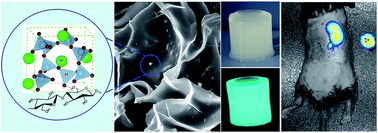Construction of cellulose–phosphor hybrid hydrogels and their application for bioimaging†
Abstract
Bioimaging is a key technique for monitoring behavior and activity in vivo and plays an important role in the life science and medical fields. In the present work, for the first time, a new, safe cellulose based hybrid hydrogel was constructed from a cellulose solution containing rare-earth doped phosphor (PP) in an alkali/urea aqueous system using epichlorohydrin as a crosslinker. Its structure and properties were characterized by wide angle X-ray diffraction, FT-IR spectra, solid-state 13C NMR, field emission scanning electron microscopy, UV-vis spectroscopy, fluorescence spectra, and compression tests. The results indicated that the PP particles were tightly embedded in the macroporous cellulose matrix, which not only supplied cavities for PP immobilization through relatively strong intermolecular hydrogen bonding interactions, but also supplied the pore wall as a shell to protect the structure and character of PP. Thus, the cellulose/PP hybrid (CPH) hydrogels emitted relatively strong green fluorescence under a UV lamp, as well as high brightness and long-lasting afterglow. This could avoid harmful radiation in the body and improve signal resolution with lower cell autofluorescence interference. Notably, CPH with strong afterglow could be detected both under the skin and in the stomach with and without excitation light, showing promising prospects as a candidate for bioimaging. Moreover, the hybrid hydrogels exhibited good compressive strength and processability.


 Please wait while we load your content...
Please wait while we load your content...